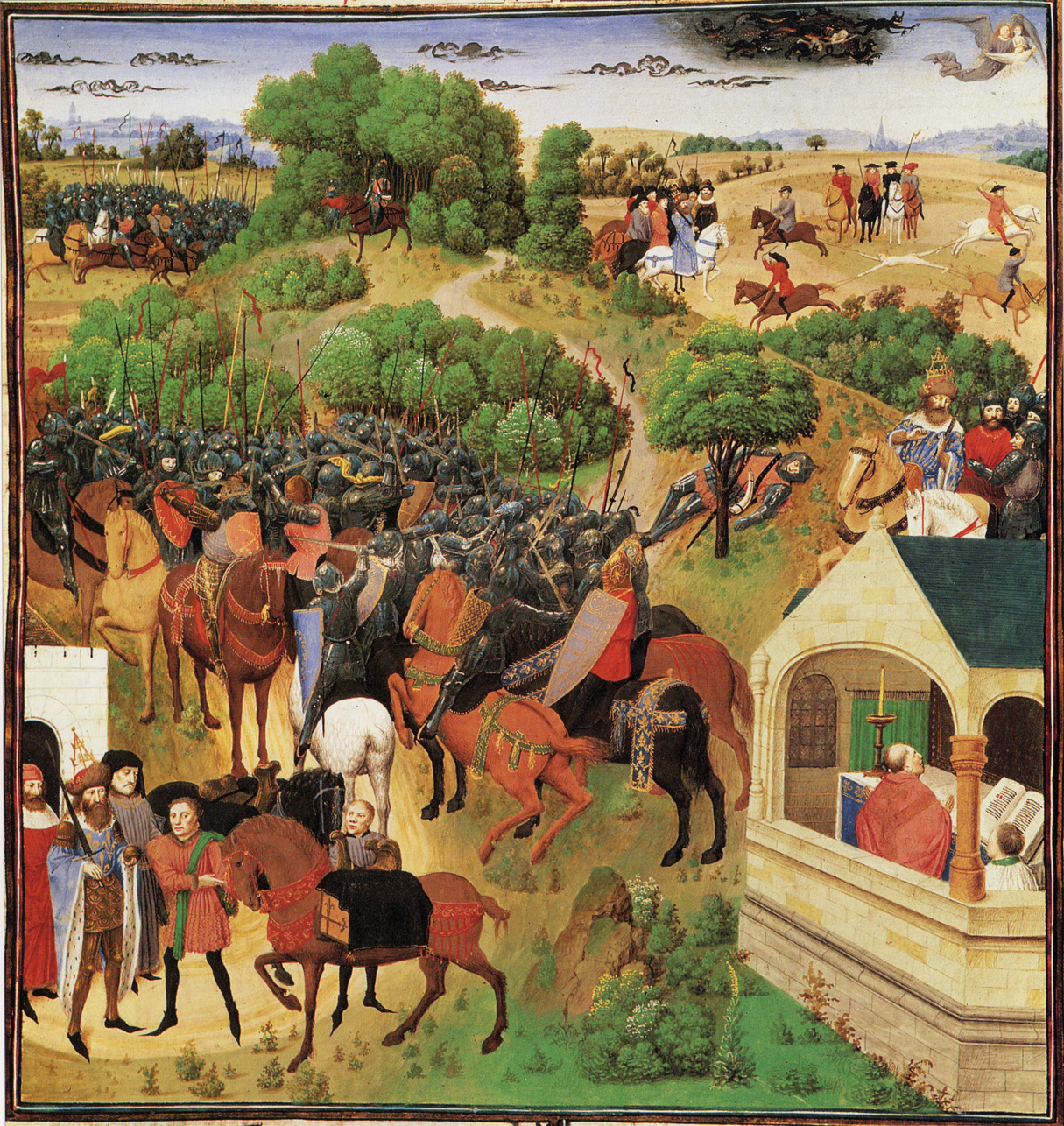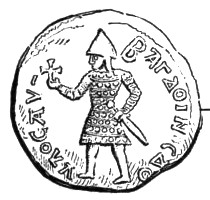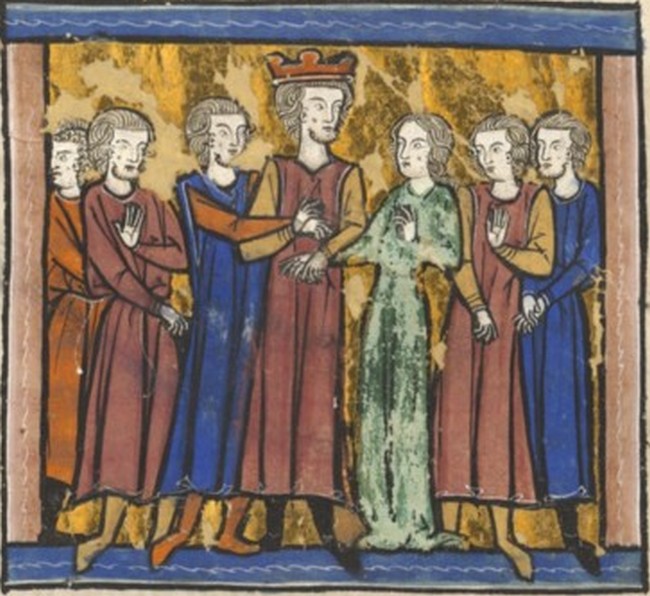|
Baudouin De Sebourc
''Baudouin de Sebourc'' is a fourteenth-century French ''chanson de geste'' which probably formed part of a cycle related to the Crusades, and may well be related to '' Bâtard de Bouillon''. The poem was likely composed c. 1350 in Hainaut. The poem consists of 25,750 lines and is retained in two manuscript copies and was printed in 1841; a critical edition wasn't published until 1940. This edition, by Edmond-René Labande, advanced two ideas about the poem. The first was that it should be dated to the middle of the fourteenth century rather than earlier in that century, and the second that it was written by two poets—the first a very capable writer with a fine sense of humor, the second a much less original one. Plot According to Claassens, the plot "is impossible to summarize ... briefly". The main character's father, King Ernoul of Nijmegen, travels to the Orient to deliver his brother from Saracen captivity. In the meantime his seneschal, Gaufroi of Friesland, takes Ernoul' ... [...More Info...] [...Related Items...] OR: [Wikipedia] [Google] [Baidu] |
Chanson De Geste
The ''chanson de geste'' (, from Latin 'deeds, actions accomplished') is a medieval narrative, a type of epic poem that appears at the dawn of French literature. The earliest known poems of this genre date from the late 11th and early 12th centuries, shortly before the emergence of the lyric poetry of the troubadours and trouvères, and the earliest verse romances. They reached their highest point of acceptance in the period 1150–1250.Hasenohr, 242. Composed in verse, these narrative poems of moderate length (averaging 4000 lines) were originally sung, or (later) recited, by minstrels or jongleurs. More than one hundred ''chansons de geste'' have survived in approximately three hundred manuscripts''La Chanson de Roland,'' 12. that date from the 12th to the 15th century. Origins Since the 19th century, much critical debate has centered on the origins of the ''chansons de geste'', and particularly on explaining the length of time between the composition of the ''chansons'' a ... [...More Info...] [...Related Items...] OR: [Wikipedia] [Google] [Baidu] |
Baldwin II Of Jerusalem
Baldwin II, also known as Baldwin of Bourcq or Bourg (; – 21August 1131), was Count of Edessa from 1100 to 1118, and King of Jerusalem from 1118 until his death. He accompanied his cousins Godfrey of Bouillon and Baldwin of Boulogne to the Holy Land during the First Crusade. He succeeded Baldwin of Boulogne as the second count of Edessa when he left the county for Jerusalem following his brother's death. He was captured at the Battle of Harran in 1104. He was held first by Sökmen of Mardin, then by Jikirmish of Mosul, and finally by Jawali Saqawa. During his captivity, Tancred, the Crusader ruler of the Principality of Antioch, and Tancred's cousin, Richard of Salerno, governed Edessa as Baldwin's regents. Baldwin was ransomed by his cousin, Joscelin of Courtenay, lord of Turbessel, in the summer of 1108. Tancred attempted to retain Edessa, but Bernard of Valence, the Latin patriarch of Antioch, persuaded him to restore the county to Baldwin. Baldwin allied with Jawali, ... [...More Info...] [...Related Items...] OR: [Wikipedia] [Google] [Baidu] |
Esmoreit
Esmoreit is a Middle Dutch drama. It is one of the four ''abele spelen'' ("able plays") contained in the Van Hulthem Manuscript and consists of 1,018 lines in rhyme. The other ''abele spelen'' are: '' Gloriant'', ''Lanseloet van Denemerken'' and ''Vanden Winter ende vanden Somer''. The play is named after the male protagonist Esmoreit, crown prince of the Kingdom of Sicily. It deals with the love between two people of different social classes and is followed by the ''sotternie'' ( farce) ''Lippijn''. One of its sources is the 14th-century ''chanson de geste'' ''Baudouin de Sebourc''. Roles *Robbrecht (nephew of the king of Sicily) *Meester (Master Platus, chamberlain to the king of Damascus) *de coninc (de king of Damascus) *de jonge (jonc)vrouwe Damiët (daughter of the king of Damascus) *de kersten coninc/sijn vader (the (Christian) king of Sicily) *de vrouwe/sine moeder (queen of Sicily and mother of Esmoreit) *de jonghelinc (Esmoreit, crown-prince of Sicily, raised at the ... [...More Info...] [...Related Items...] OR: [Wikipedia] [Google] [Baidu] |
Middle Dutch
Middle Dutch is a collective name for a number of closely related West Germanic dialects whose ancestor was Old Dutch. It was spoken and written between 1150 and 1500. Until the advent of Modern Dutch after 1500 or c. 1550, there was no overarching standard language, but all dialects were mutually intelligible. During that period, a rich Medieval Dutch literature developed, which had not yet existed during Old Dutch. The various literary works of the time are often very readable for speakers of Modern Dutch since Dutch is a rather conservative language. Phonology Differences with Old Dutch Several phonological changes occurred leading up to the Middle Dutch period. * Earlier Old Dutch , , merge into already in Old Dutch. * Voiceless fricatives become voiced syllable-initially: > , > (merging with from Proto-Germanic ), > . (10th or 11th century) * > * > or . The outcome is dialect-specific, with found in more western dialects and further east. This results in later ... [...More Info...] [...Related Items...] OR: [Wikipedia] [Google] [Baidu] |
John I, Count Of Holland
John I (1284 – 10 November 1299) was Count of Holland and son of Count Floris V. John inherited the county in 1296 after the murder of his father. Shortly after his birth, after negotiations between Floris and King Edward I of England in April 1285, he was betrothed to Elizabeth, a daughter of Edward and Eleanor of Castile. Soon after this the infant John was sent to England to be raised and educated there at Edward's court. In 1296, after the murder of John's father Count Floris V, King Edward invited a number of nobles from Holland with English sympathies, amongst whom were John III, Lord of Renesse, and Wolfert I van Borselen. On 7 January 1297 John married Edward's daughter Elizabeth at St Peter's Church, Ipswich. Soon after this, he was allowed to return to Holland, although being made to promise to heed the council of Renesse and Borselen. Elizabeth was expected to go to Holland with her husband, but did not wish to go, leaving her husband to go alone. After some dela ... [...More Info...] [...Related Items...] OR: [Wikipedia] [Google] [Baidu] |
Leeuwarden
Leeuwarden (; fy, Ljouwert, longname=yes /; Town Frisian: ''Liwwadden''; Leeuwarder dialect: ''Leewarden'') is a city and municipality in Friesland, Netherlands, with a population of 123,107 (2019). It is the provincial capital and seat of the Provincial Council of Friesland. It is located about 50 km west of Groningen and 110 km north east from the Dutch capital Amsterdam (as the crow flies). The region has been continuously inhabited since the 10th century. It came to be known as Leeuwarden in the early 9th century AD and was granted city privileges in 1435. It is the main economic hub of Friesland, situated in a green and water-rich environment. Leeuwarden is a former royal residence and has a historic city centre, many historically relevant buildings, and a large shopping centre with squares and restaurants. Leeuwarden was awarded the title European Capital of Culture for 2018. The Elfstedentocht (Eleven Cities Tour), an ice skating tour passing the eleven cities of Fri ... [...More Info...] [...Related Items...] OR: [Wikipedia] [Google] [Baidu] |
Valenciennes
Valenciennes (, also , , ; nl, label=also Dutch, Valencijn; pcd, Valincyinnes or ; la, Valentianae) is a commune in the Nord department, Hauts-de-France, France. It lies on the Scheldt () river. Although the city and region experienced a steady population decline between 1975 and 1990, it has since rebounded. The 1999 census recorded that the population of the commune of Valenciennes was 41,278, and that of the metropolitan area was 399,677. History Before 1500 Valenciennes is first mentioned in 693 in a legal document written by Clovis II (''Valentiana''). In the 843 Treaty of Verdun, it was made a neutral city between Neustria and the Austrasia. Later in the 9th century the region was overrun by the Normans, and in 881 the town passed to them. In 923 it passed to the Duchy of Lower Lotharingia dependent on the Holy Roman Empire. Once the Empire of the Franks was established, the city began to develop, though the archaeological record has still not revealed all it has to ... [...More Info...] [...Related Items...] OR: [Wikipedia] [Google] [Baidu] |
Guy Of Lusignan
Guy of Lusignan (c. 1150 – 18 July 1194) was a French Poitevin knight, son of Hugh VIII of Lusignan and as such born of the House of Lusignan. He was king of Jerusalem from 1186 to 1192 by right of marriage to Sibylla of Jerusalem, and King of Cyprus from 1192 to 1194. Having arrived in the Holy Land (where his brother Aimery of Lusignan was already prominent) at an unknown date, Guy was hastily married to Sibylla in 1180 to prevent a political incident within the kingdom. As the health of his brother-in-law, Baldwin IV of Jerusalem, deteriorated, Guy was appointed by Sibylla as regent for his stepson, Baldwin V of Jerusalem. Baldwin IV died in 1185, followed shortly by Baldwin V in 1186, leading to the succession of Sibylla and Guy to the throne. Guy's reign was marked by increased hostilities with the Ayyubids ruled by Saladin, culminating in the Battle of Hattin in July 1187—during which Guy was captured—and the fall of Jerusalem itself three months later. Following ... [...More Info...] [...Related Items...] OR: [Wikipedia] [Google] [Baidu] |
La Conquête De Jérusalem
LA most frequently refers to Los Angeles, the second largest city in the United States. La, LA, or L.A. may also refer to: Arts and entertainment Music * La (musical note), or A, the sixth note * "L.A.", a song by Elliott Smith on ''Figure 8'' (album) * ''L.A.'' (EP), by Teddy Thompson * ''L.A. (Light Album)'', a Beach Boys album * "L.A." (Neil Young song), 1973 * The La's, an English rock band * L.A. Reid, a prominent music producer * Yung L.A., a rapper * Lady A, an American country music trio * "L.A." (Amy Macdonald song), 2007 * "La", a song by Australian-Israeli singer-songwriter Old Man River Other media * l(a, a poem by E. E. Cummings * La (Tarzan), fictional queen of the lost city of Opar (Tarzan) * ''Lá'', later known as Lá Nua, an Irish language newspaper * La7, an Italian television channel * LucasArts, an American video game developer and publisher * Liber Annuus, academic journal Business, organizations, and government agencies * L.A. Screenings, a tel ... [...More Info...] [...Related Items...] OR: [Wikipedia] [Google] [Baidu] |
Crusade Cycle
The Crusade cycle is an Old French literary cycle of ''chansons de geste'' concerning the First Crusade and its aftermath. History The cycle contains a number of initially unrelated texts, collated into interconnected narratives by later redactors. None of the poems in the cycle survive independently, and the thirteen separate collections are all organized in different orders with different texts. The manuscripts were all written between approximately 1350 and 1425, in northeastern France, probably in Picardy. The original poem in the cycle was the ''Chanson d'Antioche'', which is the basis for the "historical" section of the cycle. The original ''Chanson d'Antioche'' is lost, but it was edited in the 12th century by Graindor de Douai, who also edited the ''Chanson de Jérusalem'', and possibly wrote the ''Chanson des Chétifs'' himself. These three ''chansons'' form the basis for the rest of the cycle, and are more historically oriented than the Romances that grew up around th ... [...More Info...] [...Related Items...] OR: [Wikipedia] [Google] [Baidu] |
Seneschal
The word ''seneschal'' () can have several different meanings, all of which reflect certain types of supervising or administering in a historic context. Most commonly, a seneschal was a senior position filled by a court appointment within a royal, ducal, or noble household during the Middle Ages and early Modern period – historically a steward or majordomo of a medieval great house. In a medieval royal household, a seneschal was in charge of domestic arrangements and the administration of servants, which, in the medieval period particularly, meant the seneschal might oversee hundreds of laborers, servants and their associated responsibilities, and have a great deal of power in the community, at a time when much of the local economy was often based on the wealth and responsibilities of such a household. A second meaning is more specific, and concerns the late medieval and early modern nation of France, wherein the seneschal (french: sénéchal) was also a royal officer in char ... [...More Info...] [...Related Items...] OR: [Wikipedia] [Google] [Baidu] |



.jpg)
